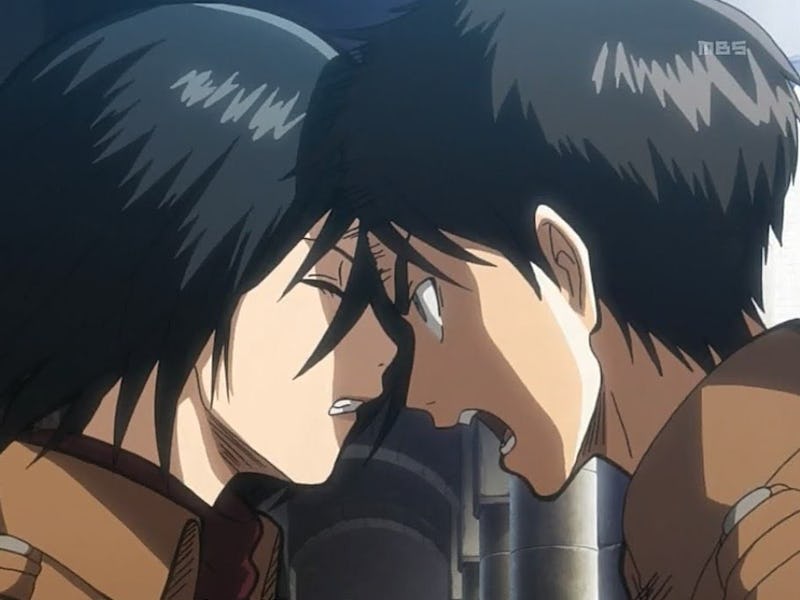Eren and Mikasa will never get together on Attack on Titan
Shippers, come on. It's been years of this nonsense.

This is the story of the saddest ship in anime: Eren and Mikasa (aka, “Eremika”). The bond between Attack on Titan's main characters Eren Yaeger and Mikasa Ackerman has been a topic of speculation for years. So why don't they ever kiss? There are multiple answers to this question, but the biggest ones have everything to do with the way contemporary anime is made.
Some background: Attack on Titan (Shingeki no Kyojin) takes place in a fictional walled city under regular siege by giant humanoid kaiju called Titans. The story’s three central heroes are Eren, his best friend Armin (AR-uh-meen), and Eren’s adopted sister Mikasa. The city is surrounded by three circular walls, which generally manage to keep the monsters at bay, but Eren, Armin, and Mikasa are all insatiably curious about the world outside. So when Eren and Mikasa’s mother is eaten by a Titan, the three kids join a branch of the military focused on exploring the world beyond the cities walls and killing any Titans they find.
Why does everyone want Mikasa and Eren to kiss?
The show depicts the emotional intimacy between Eren and Mikasa as flirtatious, and it suggests several times that Mikasa is devoted to Eren in a way that isn’t based on being his sibling. Several other characters refer to Eren as Mikasa’s boyfriend, and though she protests, she usually blushes at this suggestion. When Mikasa thinks Eren is dead, she nearly commits suicide by throwing herself at a Titan. When Eren is inside a Titan, Armin can’t bring him back to reality until Eren remembers Mikasa. Thus, their bond is presented to the viewer as the ultimate driving force propelling both of them; that’s a prime example of what fans refer to as an OTP, or “one true pairing.”
Why won't Eren and Mikasa hook up in the anime?
Anime shows fit neatly into genre categories with more precision than Western television. Though the “dramedy” has become popular among American fans, blending romance with cringe-worthy humor and moments of real tragedy, those who watch anime expect stories to take a more regimented shape. Attack on Titan, based on the manga by Hajime Isayama, is not a romance story, and that typically means there isn’t any romance happening at all.
Attack on Titan focuses on warfare, monster mythology, and class structure. However, most of its characters are teenagers, which usually means an anime will delve at least partially into flirtation. The most popular genres of action-oriented anime are mecha (Gundam), card battle (Yu-Gi-Oh, Card Captor Sakura), and monster battle (Pokémon, Digimon).
More specifically, Attack on Titan is an anime marketed generally toward a male audience. Shows like this are called shonen (for young boys) and seinen (for young men), and in order to make the distinction in advertising clear, stories for young boys almost never involve romantic relationships (though they do involve flirtations with sex, as one can see in Ghost in the Shell and most of the Dragonball universe.) Here’s the kicker, though: Attack on Titan is far, far more invested in the interior, emotional lives of its characters than the average male-oriented anime. Also, Mikasa, the show’s central female character, is repeatedly referred to as the top warrior in the military, though she isn’t sexualized like most characters in “magical girl” anime (think Sailor Moon).
If Eren and Mikasa were to embark on a romantic relationship in Attack on Titan, it would confuse the audience tuning in regularly to watch an action-packed, half-mecha, half-monster battle anime. Though Westernized audiences have become accustomed to an action star “getting the girl,” that kind of cross-genre story isn’t as popular in mainstream anime.
Eren and Mikasa: Why you should still watch Attack on Titan
Attack on Titan’s artistic merits are many, including out-of-this-world animation and the fact that the creator was inspired by Francisco Goya’s paintings. Isayama has admitted that Mikasa is his calculated attempt at a moe character, which in anime terms refers to a female character on the cusp of adulthood, one whose presence onscreen inspires a surge of affection and devotion in the viewer. In other words, she’s supposed to be a fan favorite.
In Japanese interviews, Isayama has also said it would be a real shame for Eren and Mikasa to develop only in tandem, and he suggests that Armin’s presence will go on interrupting their bond. “You meet your Mr./Ms. Right, you say ‘This is fate!,’ and you accept that the trajectory of your life is already predestined,” Isayama says. “People who interfere with that and seem to affect your serene life are portrayed as villains. Of course, I am not speaking of all mangaka (Japanese artists), but with my mentality as a male mangaka, I think it is pitiful if Mikasa’s life is only about staying together with Eren. However, for Mikasa, it is a wonderful thing to be with Eren forever. Combining what I’ve said, if I were to draw the separation of Eren and Mikasa, I feel like my portrayal likely won’t be satisfactory for readers, because Mikasa would have to endure the strain of being stuck between Eren and Armin.” Because Attack on Titan is written for an adolescent audience, Isayama keeps his cultural message in mind when writing moe characters like Mikasa. Any choice he makes for her can be read as prescriptive for Japanese youth.
Attack on Titan Season 2 is currently being simulcast in Japan and on Crunchyroll.